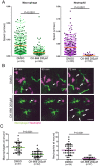Live imaging reveals distinct modes of neutrophil and macrophage migration within interstitial tissues
- PMID: 28972134
- PMCID: PMC5702045
- DOI: 10.1242/jcs.206128
Live imaging reveals distinct modes of neutrophil and macrophage migration within interstitial tissues
Abstract
Cell motility is required for diverse processes during immunity and inflammation. Classically, leukocyte motility is defined as an amoeboid type of migration, however some leukocytes, like macrophages, also employ a more mesenchymal mode of migration. Here, we sought to characterize the mechanisms that regulate neutrophil and macrophage migration in vivo by using real-time imaging of leukocyte motility within interstitial tissues in zebrafish larvae. Neutrophils displayed a rounded morphology and rapid protease-independent motility, lacked defined paxillin puncta, and had persistent rearward polarization of stable F-actin and the microtubule network. By contrast, macrophages displayed an elongated morphology with reduced speed and increased directional persistence and formed paxillin-containing puncta but had a less-defined polarization of the microtubule and actin networks. We also observed differential effects of protease inhibition, microtubule disruption and ROCK inhibition on the efficiency of neutrophil and macrophage motility. Taken together, our findings suggest that larval zebrafish neutrophils and macrophage display distinct modes of migration within interstitial tissues in vivo.
Keywords: Actin cytoskeleton; Macrophage; Microtubule; Migration; Neutrophil; Zebrafish.
© 2017. Published by The Company of Biologists Ltd.
Conflict of interest statement
Competing interestsThe authors declare no competing or financial interests.
Figures




References
MeSH terms
Substances
Grants and funding
LinkOut - more resources
Full Text Sources
Other Literature Sources
Molecular Biology Databases
Research Materials

